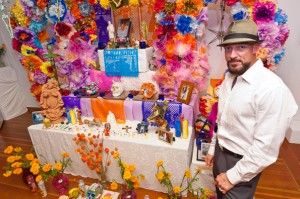Day of the Dead: a tradition of art and memory

The Mission Cultural Center is hosting a gala reception on Nov. 2 for “Death in Parallel/Muerte Paralela,” a Day of the Dead exhibit which runs through Nov. 4. On display are decorative altars, ranging from the traditional to the experimental, dedicated to friends and family members that have passed away.
The Day of the Dead, or Dia de los Muertos in Spanish, is a celebration where family, friends and communities come together to pray and remember the dead.
Mission Cultural Assistant Nicole Crescenzi said, “I’m thrilled to be a part of this exhibit, the energy that each artist puts into their work is so rich, I recognize the value of folk art and I see its relevance more than ever.”
Altars are beautifully arranged with “ofrendas” or offerings, such as sugar skulls, orange marigolds, candles, water and food then placed in homes, community centers and parks.
It is believed that the spirits return for the marigold scent, and the aroma of the foods that are offered to them on the alter.
The spirits take their offerings on Nov. 2, which is the official Dia de los Muertos, and after the spirits have departed the living consume the food and share it with their friends and family.
“Day of the Dead doesn’t only belong to Mexicans, it belongs to the community because we all mourn” said Chico Garza, a Mission Cultural Center tour guide.
“I’ve been working diligently from design to product and concept for two months,” said Paul Zinser, whose altar is dedicated to his mother Nellie Marie Friedman Peterson.
The base of the alter is usually created with stacked tiers making the elements of the altar easier to display. Generally, an altar should have an arch that represents the passage between life and death. All of the offerings on the alter should reflect what the dead enjoyed in the physical world.
“I kept to tradition with a three-tier altar,” said Zinser. “Everything in this altar has a symbolism of love, and attachment towards my mother.”
“This is a healing process for me,” said Zinser. “I sketched this idea for my mother’s alter a lot; I sketched it so much that I made a watercolor painting of it.”
“The skulls go in the middle tier always, the middle skull always has to represent the dead person, the rest can be significant things that the dead person liked,” said Zinser.
In some cases public altars are made and exhibited in galleries, parks and festivals. Most public altars allow you to leave offerings in remembrance of a loved one.
IF YOU GO
The Mission Cultural Center hosts a public party Dia de los Muertos Gala Reception on Nov. 2 with special hours from 6:30 to 11p.m.
$5 Admission, advance tickets available via Paypal
Alters exhibit is open during regular center hours until Nov. 5.
